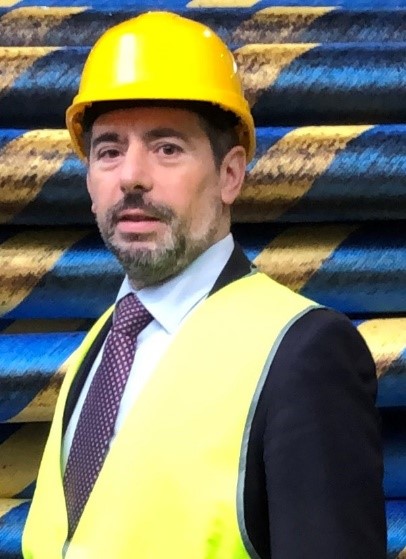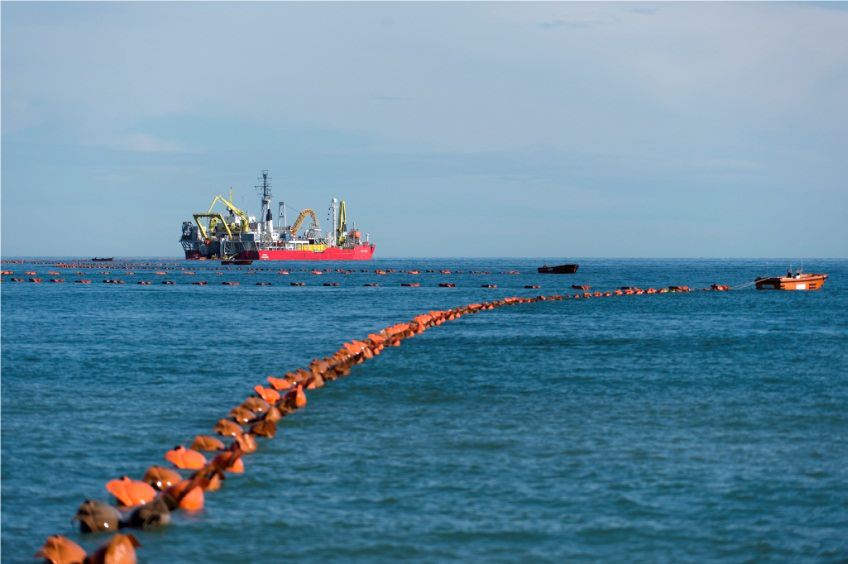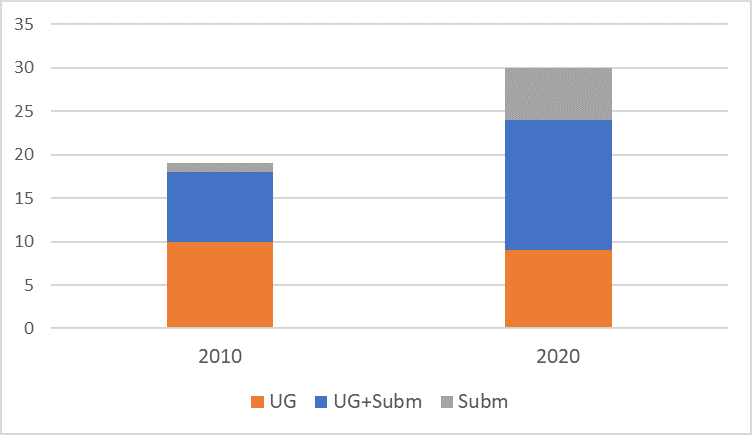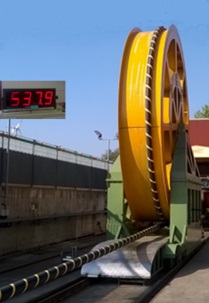Submarine cables, there's power under water!
 |
|
Marco Marelli, SC B1 Chair (IT) marco.marelli@prysmiangroup.com |
Submarine power cables are now among the most important key enablers for the energy transition.
Power generation from Renewable Energy Sources (RES) and interconnection among networks are, in fact ,the two main areas where energy links across water is developing massively and – as such – are driving the recent technological evolution.

Figure 1 – Laying activities for Submarine cables (source TB 610)
In recent years the number and size of installed offshore wind farms have increased rapidly and more and larger farms are being planned. Other types of offshore generation are expected to come in the near future, such as tidal and wave energy generation. Submarine cables are and will be an essential part of this development where they are used as array cables between the generators, as export cables to connect the offshore generation farms with the onshore transmission grid, and even as part of interconnections between different synchronous systems, countries, or price areas .
Another important factor for the energy transition is the implementation of a large electrical grid. The number of HVDC interconnectors in the construction stage is larger than ever before. Also, there are many projects in progress at various preliminary stages (planning, studies,…), and they are typically very long and with higher power ratings, thus pushing voltages to new levels with new cable technologies.
Typical drivers are the “political” change toward green energy production as well as the differential cost of energy between countries/areas that make viable and desirable the interchange of energy in parallel or in substitution of new generation plants. Interconnectors using HVAC cables are currently limited to lengths of approx. 100 km, with established technologies, but longer lengths may be possible with newer technologies, different use of reactive compensation, or with reduced frequencies.
This recent evolution of submarine cables and their broad application has been accompanied by the the CIGRE Study Committee B1 “Insulated Cables” (SC B1).
In the past five years, CIGRE published several Technical Brochure that are devoted to this specific application and have become the industry reference documents.
Table 1 – Works relevant to submarine cables recently completed and published
|
WG number |
Name of the Publication |
Publication status |
|
WG B1.40 |
Offshore generation cable connections |
|
|
WG B1.43 |
Recommendations of mechanical testing of submarine power cable |
|
|
WG B1.55 |
Recommendations for additional testing for submarine cables from 6 kV (Um = 7.2 kV) up to 60 kV (Um = 72.5 kV) |
|
|
WG B1.52 |
Fault location on land and submarine links (AC and DC) |
The growing use of submarine cables is reflected in a growing number of stakeholders. Besides users and manufacturers, there are different groups of interest e.g. academy, insurers, and the general public, that are requiring CIGRE to elaborate newer guidelines and recommendations to foster continuous progress in this field.
The attention given by CIGRE SC B1 to the technology developments and to the different cable applications underwater, is clearly visible in the evolution of the scope of the activities being performed by the Study Committee (Figure 2): in 2010 there were 9 Working Groups studying topics that were relevant to subsea applications, one of which was exclusively dealing with submarine cables; 10 years later there are 21 WGs relevant to them, with 6 Working Groups studying submarine-specific topics.

Figure 2 – the evolution of SC B1 Working Groups
The variety of topics covered (Table 2) touch the most discussed issues currently facing in the industry: improved designs, suitable testing techniques and thresholds, modern sizing methods allowed by newer informatic tools, installation techniques and their operating modes to preserve the environment.
Table 2 – Selection of active WGs within SC B1 or with a contribution of SC B1 relevant to submarine cables (in italic those specific for this subject)
|
WG number |
Title |
|
WG B1.62 |
Recommendations for testing DC extruded cable systems for power transmission at a rated voltage up to and including 800 kV |
|
WG B1.63 |
Additional recommendations for mechanical testing of submarine cables for dynamic applications |
|
WG B1.64 |
Evaluation of losses in armoured three core power cables |
|
WG B1.65 |
Installation of offshore Cable Systems |
|
WG B1.66 |
Recommendations for testing DC lapped cable systems for power transmission at a rated voltage up to and including 800 kV |
|
WG B1.67 |
Loading pattern on windfarm array and export cables |
|
WG B1.70 |
Recommendations for the use and the testing of optical fibers in submarine cable systems |
|
WG C3.17 |
Interactions between Wildlife and Emerging Renewable Energy Sources and Submarine Cables |
The evolution of submarine cable systems in the near and far future will help further improvement both in interconnectors, where an increased depth of installation will allow for new routes in deep-sea waters and for offshore RES integration, where floating structures for offshore power generation will lead the need for flexible and dynamic cables.
The challenge of deep-water cables is mostly related to their weight that for power cables is a factor 100 or so larger than the light-weighted telecommunication cables. The deepest power cable ever laid is at a depth of more than 1600 meters. Laying cables at this or deeper depths is possible by following two principle roads: lowering the specific cable weight and/or increasing its structural strength. It is essential to understand that realizing cable connections through deep waters is not only about cable design. Installation technology is equally important in that where expensive assets like installation vessels are key as well as repair procedures, since joints must be designed for deeper depths than before.
The recent need for dynamic cable systems is due to the continuous development in floating structures, especially – for its fast growth – related to offshore wind generation. When cables are connected to such floating structures they will be hanging in the water and experience movements induced by structure motions and sea currents. To improve their fatigue resistance, high voltage cables need more advanced designs that have been proven with small and full-scale laboratory tests.
Other system design aspects introduced by the movement of the floating assets imply the provision of extra length of cable, the use of weight and buoyancy units mounted to the cable, the connection of the cable to the platform with application of stiffeners or restrictors to avoid excessive bending and fatigue. The combination of all system elements must be designed such that it keeps its functionality even when experiencing the long-term, static and dynamic stresses.
|
|
|
Figure 3 – examples of full-scale testing of submarine cable deep waters
(source: paper Jicable 2019-A5.6) and for dynamic applications (source: paper Jicable 2019-C8.3)
Study Committee B1 is fully engaged to foster the evolution of insulated cables, collecting and elaborating information from different stakeholders and providing unbiased recommendations and guidance. Increased focus of activities on submarine cables has been the natural answer to growing demand, which is now progressing in the development of new challenging applications.
These newer applications are also mirrored in the growing number of papers on these topics, that will be discussed during the 2020 General Session in Paris. That will be the opportunity to verify the state-of-the-art and to promote new work items for SC B1 on submarine cables, with the aim to anticipate and support the needs of the future energy network. Join us in 2020 in Paris and to exchange experiences with submarine cables!


.png)